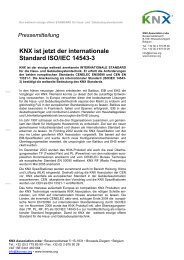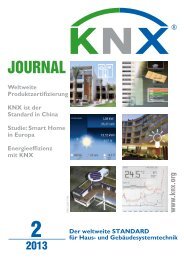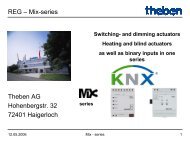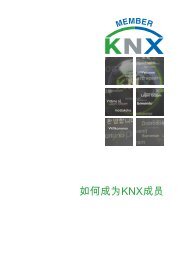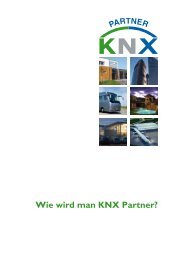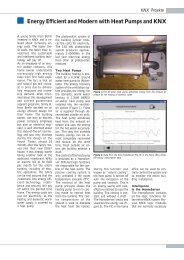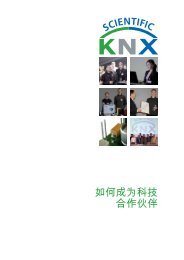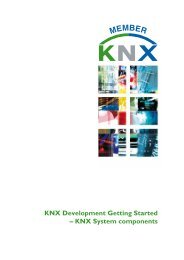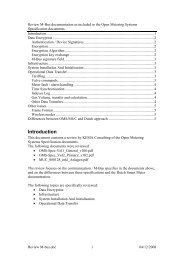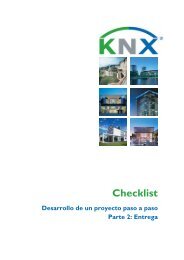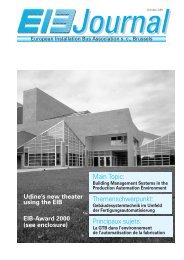KNX Journal 2011-1
KNX Journal 2011-1
KNX Journal 2011-1
Create successful ePaper yourself
Turn your PDF publications into a flip-book with our unique Google optimized e-Paper software.
<strong>KNX</strong> System<br />
<strong>KNX</strong> HVAC RF made easy<br />
Energy Efficiency with <strong>KNX</strong>: new Easy channels for <strong>KNX</strong> RF based solutions<br />
Window contact<br />
Scheduler<br />
Solar panels<br />
Heat pump<br />
Presence<br />
Detector<br />
At the 2008 edition of the ish<br />
fair and when hearing about<br />
the then new specification<br />
for OpenTherm <strong>KNX</strong> RF<br />
realizations, a group of HVAC<br />
manufacturers joined forces<br />
and set up a new Task Force.<br />
The goal of the Task Force<br />
was to extend the <strong>KNX</strong> specifications<br />
in such a way that it<br />
would be able to develop a fullfledged<br />
<strong>KNX</strong> central heating<br />
system, including hot water<br />
production, influencing heat/<br />
cool production depending on<br />
the valve positions in individual<br />
rooms and taking into account<br />
systems like heat pumps and<br />
solar panels.<br />
As this application allows to<br />
not only heat/cool rooms<br />
individually but also informs<br />
the producer of heat or cooling<br />
on the current needs, it<br />
contributes significantly to the<br />
energy efficiency of homes and<br />
buildings.<br />
During the elaboration of<br />
the extensions to the <strong>KNX</strong><br />
Standard, the Task Force<br />
agreed that the solution should<br />
enable the installer to set up<br />
the system without the help<br />
of a tool and that the solution<br />
should permit devices to<br />
communicate only wireless.<br />
<strong>KNX</strong> RF and the <strong>KNX</strong> Easy<br />
installation principle were<br />
the natural consequence,<br />
whereby it was agreed to take<br />
into account the new <strong>KNX</strong><br />
flexible E-Mode concept. The<br />
latter enables to develop Easy<br />
compatible products, of which<br />
the number of data points is<br />
not rigidly fixed but extendible.<br />
The agreed application has<br />
now been published in the<br />
<strong>KNX</strong> Application Note 138<br />
and principally works as<br />
follows:<br />
- The core of the system<br />
consists of a Room Regulator<br />
and a Central Heating<br />
Controller.<br />
- The Room Regulator can<br />
receive the necessary input<br />
data from amongst<br />
others a scheduler, window<br />
contacts, a presence detector<br />
and possibly a Room<br />
and Outside temperature<br />
sensor.<br />
- On the basis of the above information,<br />
the Room Regulator<br />
controls the connected<br />
heating or cooling valves.<br />
- The application can be<br />
extended with a Maximum<br />
Position Selector, which<br />
collects the valve positions<br />
as sent by the available<br />
Room Regulators. The<br />
Maximum Position Selector<br />
Room Regulator<br />
Room / Outside<br />
Temperature Sensor<br />
Heat / Cooling Producer<br />
then calculates the maximum<br />
position and provides<br />
this to the central heating<br />
controller.<br />
- The Central Heating Controller<br />
may:<br />
• receive the calculated<br />
maximum position of the<br />
installed valves;<br />
• receive a shift/correction<br />
of the central heating flow<br />
temperature<br />
• receive commands from<br />
a connected heat pump, allowing<br />
to turn off the central<br />
heating system;<br />
• receive commands from a<br />
connected solar controller,<br />
allowing turning off the<br />
domestic hot water production;<br />
Heating / Cooling valves<br />
Pump<br />
Heat meter<br />
• inform a connected heat<br />
meter on the actual consumed<br />
heat<br />
• influence the set point of<br />
the revolution speed ration<br />
of the connected heating<br />
pump.<br />
Next to the manufacturers<br />
involved in the before-said<br />
Task Force, members of <strong>KNX</strong><br />
are invited to start developments<br />
on the basis of this<br />
newly available extension to<br />
the <strong>KNX</strong> specifications. More<br />
information can be obtained<br />
from the TF Chairman, Mr.<br />
Joost Demarest (joost.demarest@knx.org<br />
– 0032 2 775<br />
86 44).<br />
18 <strong>Journal</strong> 1/<strong>2011</strong>




